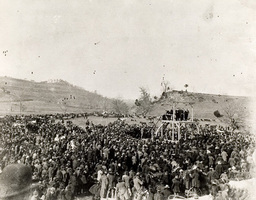 | Back to e-WV
| Back to e-WV
 The West Virginia Encyclopedia
The West Virginia Encyclopedia
 | Back to e-WV
| Back to e-WV
 The West Virginia Encyclopedia
The West Virginia Encyclopedia

John F. Morgan was the last man hanged publicly in West Virginia, on December 16, 1897, after he was convicted of murdering Chloe Greene and two of her three children in the Grass Lick area of Jackson County. The execution drew more than 5,000 spectators, including a New York Sun special reporter assigned to cover the spectacle.
The chain of events that led to the hanging began less than six weeks earlier on November 3, 1897. Morgan, a local handyman and friend of the Greene family, hid in the pre-dawn darkness with a hatchet in hand. One by one he attacked his victims, delivering fatal blows to Mrs. Greene, Jimmy Greene and Matilda Pfost. Another daughter, Alice Pfost, was attacked but survived. It was she who alerted neighbors to the crime.
Morgan was arrested within hours and incarcerated in Ripley. He was indicted on November 4, tried and convicted the following day, and sentenced the day after that. Two weeks before the hanging, Morgan escaped. He was at large two days before he was finally captured. Excitement was aroused by Morgan’s repeated oaths that he would never hang, at least on the scheduled date, but the execution happened as scheduled on December 16.
Shortly after the sensational event, the West Virginia state legislature passed a bill prohibiting public executions. It was among the first states to do so.
Several folk ballads were written about the event. Tom T. Hall’s “The Last Public Hanging in West Virginia” is perhaps the best known, made popular by bluegrass legends Flatt & Scruggs in 1966.
e-WV presents West Virginia Public Broadcasting on Last Public Hanging
Written by Jacqueline G. Goodwin
Goodwin, Jacqueline G. I Remember Well: Events Surrounding the Last Public Hanging in West Virginia. Goldenseal, Spring 1990.
Matheny, Merrilee Fisher. Swift Justice: The Story of John F. Morgan and the Last Public Hanging in West Virginia. Charleston, WV: Quarrier Press, 2020.